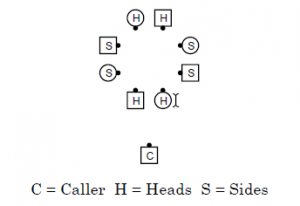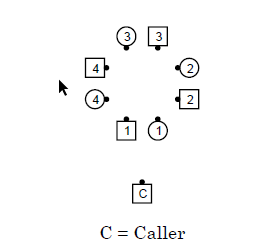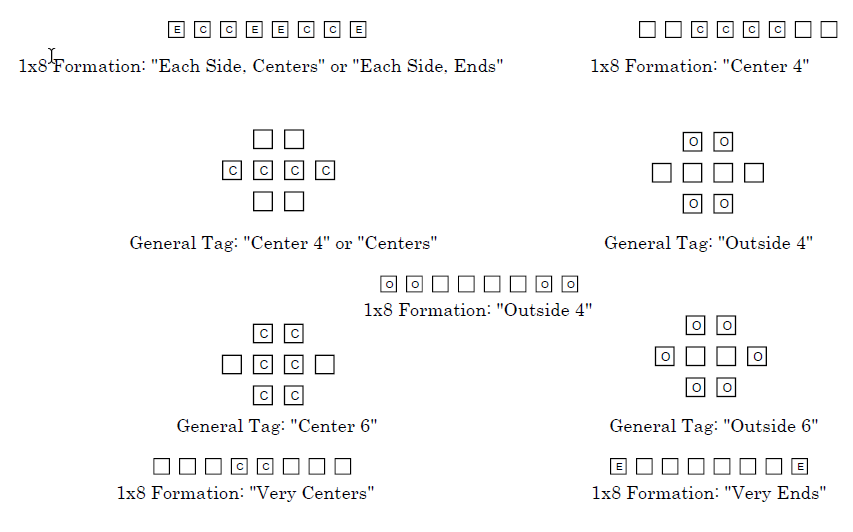Ways Of Naming Dancers
There are several ways to identify dancers in a square. See “Additional Detail: Dance Action: What does naming a dancer mean?”.
Partner / Corner
Command examples:
Face Your Partner; Dosado
Face Your Corner; Allemande Left
Circle Left; Swing Your Partner
4 Ladies Promenade Inside; Swing Your Partner
Description: From a Squared Set of Normal Couples, each dancer’s Partner is the adjacent dancer, and each dancer’s Corner is the next dancer “around the nearest corner of the square” from them.
From a Couple, or Mini-Wave, each dancer is the other’s Partner.
From an Infacing Circle Of 8 of alternating men and women, the man’s Partner is the next dancer counterclockwise around the circle from him and the corner is clockwise around the circle. For the women, the Partner is clockwise around the circle and the Corner is counterclockwise.
Partners and Corners may change throughout the dance, especially during the singing call. Each Allemande Left, Swing, or Promenade establishes a new Current Partner. Your Original Partner remains the dancer with whom you initially joined the square.
Comments: In “4 Ladies Promenade Inside; Swing Your Partner”, Partner refers to the dancer who was your partner just prior to the call.
For the purposes of resolving the square (i.e., getting dancers back to their original partners and corners) it may be useful for callers to consider the man’s corner as the next woman clockwise around the square (after adjusting Ocean Waves back to Facing Couples, having everyone face the center of the set, and blending into an Infacing Circle Of 8). This will make the man’s partner (the person the man would promenade after an Allemande Left) be the next woman counterclockwise from him, after adjustments.
Heads / Sides
Command examples:
Heads Right and Left Thru
Head Ladies Chain
Sides Wheel Around
Sides Trade
Original Heads
Those In The Head Position
Description: From a Squared Set, at the start of the tip, the Heads are the two opposing couples who are facing toward or away from the caller. The Sides are the two opposing couples who are standing perpendicular to the caller.

Dancers retain their Head or Side identity established when they first squared up. That is, “Heads” means “Original Heads”. Examples include Heads Run, Heads Trade, Sides Pass Thru, Sides Fold.
In a squared set, when the original Sides are standing in the Heads position, the caller must explicitly designate “Original Heads” or “Those In The Head Position” because simply saying “Heads” could mean either of these. Similarly for “Sides”.
In a squared set, when a mixture of Heads and Sides occupies the Heads position, the caller should explicitly designate “Head Man And The Girl With You” or “Those In The Head Position” because simply saying “Heads” could mean either of these. Similarly for “Sides”.
When a Head Man is promenading with a Side Woman, the term “Heads” means “Head Boy And The Girl With You” (e.g., Heads Wheel Around). Similarly for “Sides”.
The figure portion of singing calls almost always causes each woman to progress to a new man. Once this has happened, she temporarily takes on the Head/Side identity and home position of that man.
Some areas “rotate” or “stir the bucket” (i.e., rotate the square 90 degrees to the right so everyone has a new home position) before the singing call. This can be done by the caller as part of his last patter sequence, or by the dancers before the singing calls starts. Either way, the dancers reestablish new Heads and Sides for the singing call.
Couple #1, #2, #3, #4
Command examples:
Couples 1 and 3 make a Right Hand Star
1 and 3 Lead Out To The Right
Couple 1 Split Couple 3, Round one to a line
Description: From a Squared Set, at the start of the tip, the couple whose back is to the caller is Couple #1. The couple to their right is Couple #2, and so on.
Dancers retain their couple number as established when they first squared up.
The figure portion of singing calls almost always causes each woman to progress to a new man. Once this has happened, she temporarily takes on the couple number and home position of that man.

Comments: The phrases “Couples 1 And 3” and “1 And 3” mean the same thing as “Heads”.
Modern choreography has moved away from using couple numbers to identify dancers. See Heads / Sides (above).
Boys / Girls
Command examples:
Boys Run
Girls Trade
Men Circulate; Ladies Trade
Cloverleaf; Ladies Lead Dixie Style to a Wave
All 4 Ladies Chain
Description: The Boys are those dancers who initially squared up as the left-side dancers of each couple. The Girls are those dancers who initially squared up as the right-side dancers of each couple. The terms Men, Gents, Gentlemen, and Guys are synonymous with Boys. The terms Women, Ladies, and Gals are synonymous with Girls.
Comments: No matter the actual genders of the dancers, those who initially squared up on the left-side of each couple will play the role of Boys; right-side dancers will play the role of Girls.
Some callers emphasize that in square dancing the commands are all given to the Boys. They say that the Girls have to pay attention and do the opposite action. In modern teaching, choreography, and patter that statement is misleading and generally not true. Most of the calls are defined without reference to gender. Most of the commands are given to all the active dancers. Callers should teach and call in a way that doesn’t perpetuate this myth.
Centers / Ends
Command examples:
Each Side, Centers Trade
On Your Own Side, Centers Trade
Centers Of Each Side, Pass Thru
Center 4, Walk And Dodge
Ends Fold
Description: Dancers near the center of the square (or formation) are called centers. Dancers on the outside of the square (or formation) are called Ends. The identification of Centers or Ends is independent of facing direction.
Centers (“C”) and Ends (“E”) of some common formations:
 With 8 dancers, there are several possibilities, depending on the formation:
With 8 dancers, there are several possibilities, depending on the formation:

The caller should use “Each Side, Centers” or “Center 4” in order to avoid the ambiguity present with the term “Centers” from a 1×8 Formation.
The following are encountered less frequently, or are referred to in the definitions:

Leaders / Trailers
An understanding of Leaders and Trailers is important, as they are used to define calls (e.g., Cloverleaf) and teach calls (e.g., Zoom). Also, these terms are used by some callers during a dance (e.g., Leaders Trade).
Command Examples:
Double Pass Thru; Leaders Trade
Lines Forward And Back; Pass Thru; Tag The Line; Leaders U-Turn Back
Description: In any box-type formation (e.g., box circulate, tandem couples), those facing out of the box are Leaders and those facing into the box are Trailers.
In other 2-dancer formations (e.g., a tandem, facing dancers, back-to-back dancers), those facing directly away from the center of the 2-dancer formation are Leaders, and those facing directly toward the center of the formation are Trailers. Anyone else is neither a Leader nor a Trailer.
In the diagrams below, the dancers marked “L” are Leaders and the dancers marked “T” are Trailers.
![]()
Comments: At Mainstream, the use of Leaders and Trailers is usually restricted to tandem couples or tandem dancers.
Often there is more than one option for designating active dancers. Even though “Leaders/Trailers” may be correct, the more commonly used “Boys/Girls”, “Centers/Ends”, “First/Next” might be a better choice for dancer success.

